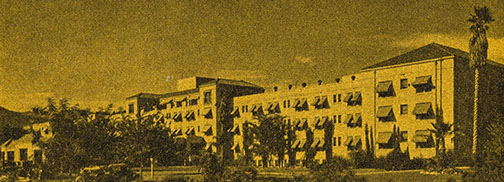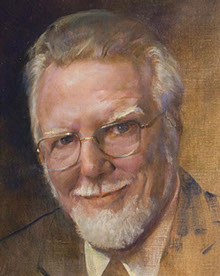

About half a century ago, as a young internist just starting practice, I would make rounds at the old Glendale Sanitarium And Hospital, as it was called then. But originally, at the turn of the 19th century when it was built, 30 years before I was born, it was called The Glendale Sanitarium, “sanitarium” being the designation for a patient care facility designed for the care of long-term patients with chronic diseases, like TB or chronic arthritis. I believe some of the guests were not sick but old and lived there as at a retirement or veterans home. There were few actual “hospitals” back then.
It was a 3-story coarsely stuccoed brick structure laid out in a simple straight line a half a mile from end to end, seemed like it anyway, and on each side of the single, central hall a single row of simple patient rooms uncluttered by either TV or medical equipment, with comfortable patient beds rather like hotel beds, each with a squeaky hand crank at one end. It seemed the most serene design for long-stay patients, who paid by the month, maybe the year, not the day.
A lovely place, atop a knoll overlooking the city, the only hill in the city proper, it was situated on a quiet winding residential road, Wilson Terrace. Long Before TV, for entertainment the hospital offered a large library and trained librarians for patients or resident guests who would come and spend hours reading good books. Unknown to modern hospitals was a large oak-paneled dining room with many mahogany tables waited on by uniformed waitresses and the guests would come to dinner dressed in evening wear. A cavernous portico with a goldfish pond and many potted palm trees and tables and lounges led to the hotel-like lobby, where uniformed bellhops (called "call boys") stood at at ease. And there was a large solarium on the roof, with a shuffleboard and simple games. The head of the hospital, then called the Administrator, was ensconced in a single-room office, actually a modified patient room, and you could go right in. The grounds were extravagantly landscaped with lawns and old trees, and a real zoo with monkeys and parrots, for the enjoyment of strolling long-term patients. And I enjoyed it too, as a kid waiting outside, after church, while my dad, a “general practitioner” as generalists were called in those days, made noon rounds on his patients. This was in the late 1930s.
When I myself was a doctor and practicing there, the 1960s, the library had become a deserted lounge, all the bookshelves and books having been removed (a rack for the L.A. and New York Times remained), the elegant dining room had been stripped of wall panels and used as a staff conference room. The zoo was gone, replaced by a large wing for the new Emergency Room and many surgery suites for the vast increase in surgery being done. But the floor plan with its very long halls remained unchanged.
Now the majority of patients were acutely ill and stayed only 2-3 weeks, at most. Leaving little room for guests, the then-latest equipment was being installed in selected patient rooms – respirators tended by technicians, automated intravenous dispensers with timers, inlying venous catheters, arterial cutdowns, electrocardiograms and arterial gas analyzers on mobile carts. The beds had grown large and could be configured in several ways, by 4-5 cranks (I never could figure them out). Affixed to the walls of most rooms were bulky 12” B&W CRT TVs. “General Hospital” always seemed to be on. The radiology department was experimenting with the newly installed CAT scanner, and looking to do coronary angiography. It was rumored that a bright young doctor, just out of angiography fellowship at UCLA, would be coming. A large clinical laboratory attached to the main building had been built, and already automated blood chemistry machines were humming away, and technicians would make morning rounds and collect many tubes of blood from sicker patients. Accordingly, the name of the place had been changed to The Glendale Sanitarium and Hospital, and would soon be changed again simply to Glendale Adventist Hospital.
I had just come from training at a Harvard hospital, and had successfully passed the Internal Medicine specialty boards, and felt like the cat's meow. I made rounds morning and evening, before and after my day in the new medical office building, just down the hill.
This particular morning I was starting the third floor, accompanied by the head nurse pushing a cart with a vase of carnations and a stack of the charts of patients I would visit, also the intern assigned to my service that month, a medical student, and two student nurses. I would be visiting two very old men, both 85 or 86 years old, both terminally ill with advanced metastatic cancer. Their rooms, 3003 and 3153, were at opposite ends of the long hall. Yesterday I had shown the medical student how to palpate the massive livers, also the ballottement maneuver for ascites. In my prime doctors still carefully checked hearts sounds with their stethoscopes directly on the patient's skin.
Our entourage approached room 3003. Just outside the door, waiting for me, there was a group of 12 or 13 of the family, several generations, agitated, distraught, angry, some frankly hysterical; bleary-eyed from staying up all night.
An aging man, I knew him to be the old man’s son, started the talking, quickly joined by most of the others all talking or shouting more or less at the same time. “Doctor, can’t you do more for Mr. Hardley? Do everything, everything, anything! You must! You can’t let him die! Has he had a CAT scan? He needs more blood, we’ll all donate. Give him more oxygen; antibiotics, oh, more antibiotics. Call in a special duty nurse, call consultants – do everything. Why hasn’t the laboratory technician been here yet? When is the kidney specialist coming? Why doesn't he have a special duty nurse? You simply must not let him die! It can’t happen! It would be inhuman not to do everything, anything, everything. It would be malpractice. You're standing in God's stead, don't you know that? Spare no expense! You'll be hearing from our lawyer.”
A little less buoyantly than usual, we made our way to the opposite end of the hall. Waiting there was another family, distraught, crying, bleary-eyed, most of them were holding hands or hugging, hushed, heads down. “Doctor, please, please have mercy!" one of them, a middle aged lady, finally pled, sobbingly. "Mr. Hart is in misery, such misery, and you’re torturing him! He doesn’t need all that oxygen. That mask is suffocating him. Please don’t force it on him. He can’t stand all that blood. Why did a kidney doctor come to see him? He doesn’t need those antibiotics, he shouldn’t have it. So many medicines. He doesn’t need all those tests. We’re all here, we’ll watch him, and his pastor is here too, he doesn’t need the special duty nurse. It’s inhuman. Please, you’re standing in God’s stead, don't you know that? Please let him have peace. It’s time for him to go. All of us agree. Why are you piling up expenses? We have prayed about it with the chaplain.”
That was long, long ago. I’ve been retired for decades. Years ago I moved away from Glendale. The old 3 story brick building is long gone, demolished, replaced by a complex of buildings all together twenty times larger by volume than the hospital I knew. It is now called the Glendale Adventist Medical Center because most of the floor space is for outpatient surgery and various specialty facilities. But I understand that it does have around 500 hospital beds, telemetry wards, intensive care units. Looming over State Highway 134 (the Ventura Freeway), it is the largest structure in a city now taken over by high-rise office buildings.
I’ve driven by the place, driving the freeway, but never stopped, never been inside. Driving fast, I glance over at the sprawling complex of buildings. The main tower appears to be two or three times taller than my old hospital, but it can’t have halls as long as the ones where I used to make rounds. I see no grounds at all. Instead, two or three huge parking structures where the lovely grounds used to be. No zoo. But what I’m really seeing are two anxious families of dear old gentlemen, each at the end of his life – one group seems to be armed -- positioned at opposite ends of an endless hall.
The place is different, so much more magnificent. But in the way that counts? In the way that was the reason why the hospital was established by Adventists over a century ago, as "the right arm of the message"? And the message back then was not just to heal but to tell the sick of the Great Healer. Looking back, I would have done it differently. My purpose should have been to somehow introduce both groups, at the opposite ends of the hall, to Him, to whom both the old men will soon be answering.

